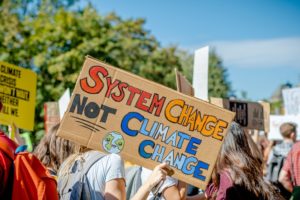From the Individual to the System

To view the photo-rich magazine version, click here.
Originally appears in the Spring 2021 issue.
By Isaac Bell and Holly Giacomodonato
Today’s youth are increasingly engaged in the fight against climate change, and for good reason. The scientific predictions paint a dark picture of a world where extreme temperatures, natural disasters, and loss of biodiversity are commonplace. Even with role models such as Autumn Peltier, Vanessa Nakate, and Greta Thunberg inspiring millions of youths to push for positive change, it can be difficult to accept the responsibility of addressing climate change when those who have known about it for so long have done so little to mitigate this crisis. Much like learning about other aspects of our world, the journey of becoming ‘climate aware’ looks different for every young person. This article will begin with a discussion of a trajectory that students may experience as their awareness of climate and environmental issues develops over time. Broadly speaking, individual actions (turn off the lights, pack litter-less lunches, etc.) are often emphasized first, followed by a gradual comprehension of more systemic challenges (e.g., corporate pollution). In this article, we will also offer suggestions for teachers (of all grades and disciplines) to help their students grapple with these topics without imposing predetermined opinions or biases on them.
In Leonardo DiCaprio’s infamous environmental documentary Before the Flood, DiCaprio describes first getting involved in the environmental movement in the early 2000s and explains that “back then everyone was focused on small individual actions… and it boiled down to simple solutions like changing your lightbulb… but it’s pretty clear that we are way beyond that now”[1]. Now almost 20 years later, many environmental awareness campaigns, policies and incentives, and educational measures are still heavily focused on individual actions[2]. However, suggested actions for leading a ‘green lifestyle’ are no longer quite as simple and non-disruptive as everyday consumer choices like buying more efficient lightbulbs. Lowering your personal carbon footprint requires a close examination of your dietary habits and modes of transportation, as eating meat (especially beef) and flying are two of the largest contributors to personal carbon footprints[3].
This content is restricted to subscribers only.
If you are not yet a subscriber, please consider taking out a subscription here.
If you are an existing subscriber, kindly log in or contact us at info@greenteacher.com for more information.





